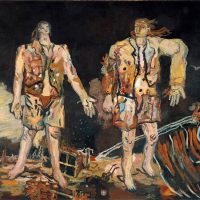For more than fifty years, continuous renewal and critical (self-)reflection have been at the centre of Georg Baselitz’s rich ouvre, comprising, according to the artist himself, more than 2,500 paintings, and a significant body of sculptures, drawings and prints.
The approach to his own past and passing time serve as the backbone of the Budapest exhibition, too. Day after day, Baselitz reviews, recreates and replays particular segments of his past. He does not wish to safely deposit the pictures of his memories and his self-image in glass cases, but rather to pick them up again and again, removing them from their original historical context and period. He brings past details into the present, and adapts them to the new place and time, thus creating a new tradition and a ‘new past’. Day in and day out, he inimitably repeats the past.
Questioning the European tradition based on figural representation and conveying messages in art, Baselitz arrived at a turning point in his career in 1969. From this time onwards, he turned the motives in his pictures upside down, which became his trademark.
In the struggle that lasted decades between figurative and abstract painting, Baselitz chose to follow a third path, one of his very own: his chief artistic objective is to continuously examine the potentials and framework of painting. His radical views about art and his dramatic, perpetually renewing palette and forms have made Baselitz one of the most innovative and autonomous figures of the post-World War II fine art scene.



